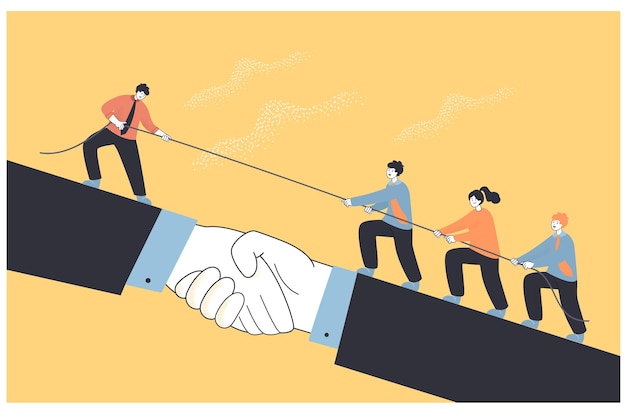Motivating employees to achieve personal or corporate objectives plays a critical role in all businesses, whether privately held or owned by the state. There are numerous motivational theories, many of which relate to or impact outcomes related to employee work satisfaction. The three primary categories are process theories of motivation like the expectancy theory, content hypotheses, and contemporary models.
Process theories of motivation, such as Vroom’s expectancy theory, can describe how motivation develops and results in fulfillment. Goal-setting, feedback, and work design theories are all included in modern motivational hypotheses — in addition to equity, agency, and control theory.
Process theories of motivation can be grouped based on their concepts and goals. Still, a thorough investigation shows that all of them are interconnected and contribute to workers’ satisfaction with their work.
Table of Contents
What Are the 8 Primary Process Theories of Motivation?

Maslow’s Hierarchy of Needs
Maslow’s theory has its basis on the idea that people desire to improve what they aim to accomplish in their lifetime and that the requirements are given priority as per their significance.
Maslow’s hierarchy of needs serves as the foundation for job satisfaction-related process theories of motivation — which focus on the wants of workers and the elements that contribute to their ability to be reasonably happy.
Maslow developed a five-stage model that classifies and emphasizes the requirements of the person depending on humans’ fundamental physical, biological, interpersonal, and emotional needs.
These groups are physiological requirements (food, shelter, clothes), physical safety (security and protective measures), social needs (connection with others), esteem, and self-actualization (getting praise from peers).
The categories are in the above sequence of decreasing importance. Maslow’s hierarchy of needs is the foundation of process theories of motivation that describe job satisfaction.
Herzberg’s Two-Factor Theory
Herzberg’s Two-Factor theory, sometimes called Motivator-Hygiene, was born from his research with engineers and accountants to understand what makes people happy or uncomfortable about their jobs.
Herzberg identified five characteristics of work—accomplishment, acknowledgment, the profession, responsibility, and advancement—as “satisfiers” for workers.
At the opposite end of the spectrum, Herzberg highlighted variables that may demotivate workers, including organizational dynamics, management style, monitoring, remuneration, relationships in the workplace, and conditions of employment.
Organizations are increasingly using Herzberg’s approach to provide their employees with opportunities for self-improvement, development, and appreciation.
Staff members should receive responsibility for determining how to undertake activities related to their professions, as well as promotion after finishing certain phases of their careers and acknowledgment for particular achievements, including when they generate remarkable outcomes in their work areas.
McGregor’s X and Y Theories

Characterized by two underlying assumptions, McGregor’s Theory X and Theory Y classifications are the third among the primary process theories of motivation — which categorize workers into one of the two categories.
The presumptions of Theory X adopt a pessimistic viewpoint on individuals: People may have innate hate for effort and evade it whenever possible. As a result, getting employees to work often requires coercion, control, direction, and threats of penalty. They crave safety, avoid taking on too much, seek to be guided, and lack ambition.
According to the principles of Theory Y, work-related emotional and cognitive inputs are equivalent to leisure or recreation. Risks on the outside and other external variables may not be the only motivators for making an effort.
Employees can be cautious and disciplined to attain goals. However, their eagerness to dedicate themselves to the targets depends upon the benefits of that type of success. In typical situations, people might learn to acquire responsibility rather than accept it.
Ad: PlayAblo’s Enterprise-Grade Micro-Learning platform is built for millennial learners. Micro-Learning, assessments, and gamification features ensure learning outcome measurement and sustained engagement.
Find out more and request a custom demo!
McClelland’s Need Achievement Theory
According to McClelland’s Need Achievement hypothesis, some individuals are inspired to succeed by their need for personal accomplishment instead of benefits for themselves. The above type of process theories of motivation is easily adaptable to academic settings.
For instance, it describes why certain educators, despite the challenges they encounter, are overachievers. They strive for success, and achieving the related targets is what motivates them.
Maslow’s hypothesis is similar to Alderfer’s ERG theory, which condenses Maslow’s five types of requirements into three:
- Relatedness (self-worth and social needs)
- Progress (self-actualization)
- Sustenance (safety and physiological conditions)
The Equity Theory

Process theories of motivation describe “how” fulfillment occurs in contrast to “what” motivates people. According to this principle, workers will measure their contributions to a task against the results they get in return. The more significant the incentives, the more satisfied they are.
As per this notion, employees would feel confident with their jobs if they believe they get more in return for their efforts beyond what they invested in them. The profession itself can have some effects on how an individual views it.
Clearly stated tasks result in higher work satisfaction because a committed workforce that is dedicated to their career and actively participates in it is produced. The researchers highlighted the following five aspects of work, which can impact their motivation levels, job satisfaction, and absenteeism rates.
The elements are — the number of skills required to complete a given task, the nature of an initiative, the importance of a project, autonomy, and inputs from the management.
Employees evaluate their input-output ratio compared to their peers, and if they believe it is equitable, they will be satisfied. Employees become unhappy and less motivated if they think their input-output ratio is unfair compared to that of other employees.
Value-Percept Theory
Since employees working in different firms have diverse value systems, according to this hypothesis, people’s degrees of work satisfaction may vary depending on their personal values.
According to the Value-Percept theory, the discrepancy between expectancies and what’s obtained might cause dissatisfaction based on how vital the task is to an employee.
This idea could have a problem because there can be a connection between what individuals want and what they value highly. Though conceptually distinct, these ideas are difficult to separate in practice.
Vroom’s Expectancy Theory
According to Vrooms’ expectancy theory, conduct results from the decisions that can be given priority. The goal is to increase employee happiness and decrease occupational stress.
Human characteristics like personality and aptitude influence performance. Additionally, according to this type of process theory of motivation, factors like warmth, usefulness, and expectation prove that success, drive, and energy are all related to a person’s motivation. Better performance is correlated with greater efforts put forth at work as per the Expectancy Theory.
Porter-Lawler Model
The Polar-Lawler theory is a thorough and complete explanation of motivation considering various factors. The interwoven relationship between organizational performance and attitudes that adequately describe managers may be described in detail by this framework.
The hypotheses underlying human behavior are also mentioned in the model. The theory’s deductions presuppose that each individual’s behavior is logical, subject to intrinsic and extrinsic factors, that they make choices regarding their behavior, and that they have unique wants, objectives, and aspirations. Individuals then choose between potential behaviors.
Risk Assessment of Low Morale Workers in Organizations

When it concerns the firm’s day-to-day activities, unmotivated employees present a threat. Some personnel uses corporate equipment and materials regularly, including some that require the utmost care and safety.
Therefore, the company should provide the workforce with a balanced working force. The firm should also consider its employees’ emotional needs regarding work-related concerns.
Operational Risks
We define Absenteeism as an employee’s failure to arrive at work on time as specified. According to this definition, absences due to vacation time, service in the military, block release hours, and suspension don’t constitute Absenteeism.
It would be best if you entirely disregarded these situations in assessing Absenteeism that follows. Again, Absenteeism is also defined as an individual’s chronic or persistent failure to report for duty.
This is particularly worrying when the sequence of absences implies that their no-show was either preventable or that s/he failed to fulfill their obligation to the company under their employment agreement or their legal system to report to work on a continuous and reliable basis.
Ad: PlayAblo’s Enterprise-Grade Micro-Learning platform is built for millennial learners. Micro-Learning, assessments, and gamification features ensure learning outcome measurement and sustained engagement.
Find out more and request a custom demo!
- Subpar work: Disgruntled workers will not operate at their peak level, leading to deficient services and goods that won’t be relevant in the industry and will cost a company money.
- Toxic Workplace: Friendly and reciprocal relations between workers will be strained. Since staff morale is low, this will impact behavior and attitudes.
Personnel Risks
Organizations want to retain their employees for long durations. Organizations devote a significant deal of time and energy to staff training.
High employee turnover brought on by disgruntled workers would cost the business every dollar it has invested. As a result, operations inside the business will be disrupted, and it will take more money to retrain new hires and replace lost people.
Developing effective management is essential for a company to achieve its goals. The company’s operations may be in danger due to a leader’s unfavorable traits.
Risks to Reputation
Whenever one person lacks motivation, it can negatively affect the mood of the rest of the organization. Avoiding this situation will help prevent employees from quitting if they are unhappy with their jobs.
To appease their consumers and keep them coming back again and again again, professionals must operate to their fullest potential. Consumers can quickly spread accusations about a business if dissatisfied with its service, and the news can spread rapidly, damaging the brand’s reputation.
Environmental Risks
Employees dissatisfied with the company will show their discontent to the public. Unhappy staff will inevitably behave aggressively and with resentment toward consumers. Employees will routinely provide subpar customer support, damaging the company’s reputation. A firm must follow even rules that have an environmental impact in addition to domestic regulations.
Health Threats
Workers who aren’t completely satisfied at work may experience stress and other health issues. Stress-related ailments endanger workplace wellness initiatives to keep staff healthy. Employees who are stressed and uninspired may create mishaps at the workplace when utilizing machinery and other risky instruments.
It is widely acknowledged that occupational stress and other psychological variables pose a severe threat to the well-being of employees and companies. All organizational levels are accountable for protecting the firm’s hazards and aiding in their avoidance.
Financial Risks
Highly motivated staff members always give their jobs their all, increasing business productivity. More output from production at workplaces will enable it to produce much-needed revenue.
Absenteeism will decrease if people are content, saving their companies money. Economic conditions that make it exceptionally difficult for businesses to operate might have a financial meltdown. The challenges in purchases will then follow.
The Significance of Workplace Motivation
An employee’s enthusiasm and willingness to work hard and generate results might inspire others. A person uses this type of motivation on their initiative to improve their feelings and achieve goals. External stimulation, however, uses an outside force, like an incentive, to increase an employee’s ability and determination to work.
Workers often work for pay in return for their arduous effort, and how far individuals go relies on how driven they are. An employee’s salary is influenced by how well they achieve at work, but since it’s an external reward, they might not have any control over it.
Other extrinsic factors, such as career advancement, job stability, and wage increases, in addition to incentives, may lend purpose to workers’ motivation. Therefore, firms should continue to develop tactics that might aid in inspiring their workers if they want to maintain their existence and retain their current workforce.
Conclusion
Employee productivity in a company depends heavily on motivation, and leadership or leadership style plays a significant part in this. Non-financial incentivizing techniques also can be employed to get the best performance out of workers because motivation isn’t always dependent on monetary incentives. Although each person has aspirations, it’s the leader’s task to build and match with theories that would help their people feel satisfied in the workplace.







Comments are closed, but trackbacks and pingbacks are open.